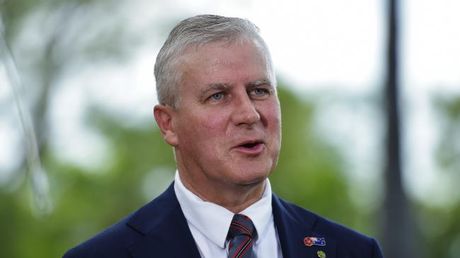Update 26 February 2018: how it turned out.
Michael McCormack: the last of the line? (Queensland Times)
After a glitch a few days ago, Michael McCormack MP seems to be favourite to become Leader of the Nationals and Deputy Prime Minister. Since December, Mr McCormack has been Minister for Veterans’ Affairs, Minister for Defence Personnel, and Minister Assisting the Prime Minister for the Centenary of Anzac. But if he becomes Leader, he will almost certainly take on a more senior portfolio or portfolios.
This change provides an opportunity to shake up the Veterans’ Affairs portfolio, known decades ago as Repatriation. Rather than cycle another junior minister through the portfolio, why not get rid of it? While the former Minister, Dan Tehan, oversaw the beginnings of much-needed systems changes in DVA, and brought in some useful initiatives in areas like veterans’ health and transition to civilian employment, the department still carries many of the characteristics that it had in the days when Reg Swartz (Minister for Repatriation in 1963) agreed that ‘Minister for the RSL’ was a reasonable description of his role. Since then, though, DVA has sidled into commemoration and education, as the numbers of veterans from World War II and Korea dwindled (under sub-heading, ‘In the small print’) and the department looked for new roles to justify its continuing existence.
These days, with the troubles of the RSL, in New South Wales and nationally, and the rise of other veterans’ advocacy groups from the Vietnam Veterans’ Federation to Soldier On, identification with the RSL is problematic. Without the RSL prop, DVA is even more of an anachronism, a backwater, a boutique department in funding terms but with a reputation as bloody-minded and having a penumbra of disgruntled clients, particularly among younger veterans.
Much of DVA’s budget is locked-in under legislation, but it has to splash a good proportion of the remaining, discretionary expenditure on commemoration, mostly because its political masters see electoral benefit in fronting commemorative events. Semi-sacred Anzackery is good for politicians to be seen with but takes funds away from more deserving causes.
 Reg ‘Curly’ Swartz, ‘Minister for the RSL’, 1961-64 (Airways Museum)
Reg ‘Curly’ Swartz, ‘Minister for the RSL’, 1961-64 (Airways Museum)
Two or three Ministers back, Honest History looked at the history of the Repatriation-Veterans’ Affairs portfolio. There, and again in the final chapter of The Honest History Book, we proposed some changes:
- distribute the benefits and assistance areas of DVA across the Departments of Health, Human Services, and Social Services (for economies of scale, grouping of like functions, and clustering of expertise);
- move the Office of Australian War Graves to the Defence portfolio (which runs the wars that produce the graves);
- split DVA’s commemoration and education functions between Defence (similar argument to War Graves) and Education and Training (to end DVA’s disproportionate treatment of military history for schools and force this subject to compete with other history subjects for funding);
- abolish the function of ‘Minister Assisting the Prime Minister for the Centenary of Anzac’ (in 2018 ‘Peak Anzac’ has long passed, as shown by declining numbers at events: update 30 January 2018; earlier posts in Centenary Watch column); and
- return the Australian War Memorial to a cultural portfolio, from whence it was removed more than 30 years ago*, under pressure from the RSL. Communications and the Arts would fit the bill.
* Michael McKernan, Here is Their Spirit: A History of the Australian War Memorial, 1917-1990, University of Queensland & Australian War Memorial, Brisbane, 1991, pp. 328-31.
24 February 2018 updated



Leave a Reply
You must be logged in to post a comment.